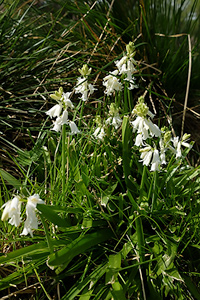Photo Corners headlinesarchivemikepasini.com
![]()
A S C R A P B O O K O F S O L U T I O N S F O R T H E P H O T O G R A P H E R
![]()
Enhancing the enjoyment of taking pictures with news that matters, features that entertain and images that delight. Published frequently.
A Tiny Miracle



23 April 2020
We change the image on the home page of our personal site every season. And for spring, we went with one of the more elegant little blossoms in our garden. The flowers arranged themselves so nicely, we thought we'd revisit the image here.

A Miracle. Captured with a Nikon D300 and 35mm Nikkor at f16, 1/60 second and ISO 400.
Every spring these little flowers come up out of nowhere along the fence that runs down the southwest side of our property. A few seem to come up inexplicably in the garden itself. We didn't plant them and no birds seem to have been involved.
We have in the past uprooted a few out of curiosity and found a bulb at the bottom. But we didn't carry our examination any further than that.
As the saying goes, we thought we were wrong once, but we were mistaken.
We've always thought of them as a lily of the valley but it turns out we were mistaken.*
We tossed this exact image at Pl@ntNet and it immediately came back with allium triquetrum1 or amaryllidaceae or, in English (more or less) triquetrous garlic.
Garlic?
We investigated further at the Wild Food Huntress where we learned the whole thing is edible. Flower, stems and bulb. "The plant is in the onion family and has more of a subtle onion garlic type flavor," she writes.
So we investigated a little further by stepping outside into the sun to pick a stem off one. It reminded us of the days in our childhood at the park when we used to pull up a blade of grass from the ballfield and chew on it like we were destined for Candlestick Park.2
We didn't taste anything. Not even anything subtle.
The Huntress Kate Grigg insists you can do a lot with them:
The leaves can be eaten raw in salads or chopped and sprinkled over pasta dishes. The leaves can also be cooked and added to stews, soups or even stir fried.
The flowers can be added to salad or dehydrated and added to breads or sprinkled on to any dish where you would like a garlic flavor.
The bulbs can be used exactly as you would garlic or also preserved like a pickled onion.
The grocery store shelves may not be stocked as full as we're used to but we've discovered a new food source right at our feet.
And that's not all. The thing has medicinal properties, according to the Grigg:
This plant has be used to help reduce cholesterol levels, aid the digestive system and a cleanser for the circulatory system. It may also have anti-viral, anti-bacterial and anti-fungal properties.
Anti-viral? That would be a small miracle.
We're putting footnotes and sidenotes like this another way, too.
Or to put it another way,* please line up six feet apart on the sidewalk and we'll get to you as soon as we can. One plant per person while supplies last.
But, as our photo demonstrates, we think they make you feel better just by looking at them.

Comments
I enjoyed your article Tiny Miracle as in our woods that surround the house we are inundated with the stuff, it is all over the place. The scent and presumably the flavour, is not at all strong at the moment but it tends to get a lot stronger as the season goes on.
I have never used it in cooking but apparently the leaves ground up do make a particularly nice garlic butter! Some of my friends in the monastery are very fond of it on toast.
-- Andrew-Bede
P.S. Attached is a photo of some of our wild garlic!
Garlic butter on toast sounds very civilized for the wild bulb's leaves. We're going to have to give that a try! -- Mike